A leading Australian professor of food microbiology believes the final product testing of fruit and vegetables is not solely an effective control strategy in controlling bacterial and viral outbreaks; rather, it is about safety measures in every step along the supply chain.
Deputy Head of the School of Agriculture and Food Sciences at the University of Queensland (UQ Mark Turner says that it cannot ever be 100% guaranteed that a food type is safe, but it is about managing the risk situations. He added that sporadic testing can often miss contamination infections because only a small percentage of total production is actually checked.
"Fresh produce is minimally processed and there is no 'cook and kill' step with most of it," he said. "We do washing and sanitization, but this is only partially effective in removing or washing away those pathogens or killing them. So, we need to consider the risks along the entire supply chain to control these issues. When it comes to food poisoning outbreaks - and they happen - fresh produce has a very short shelflife, so it can be difficult to trace back the source of that contaminated fresh produce, because by the time that people get sick, get tested, confirm an outbreak, and then go back and try to identify the source of it, it is all washed through the system so they can't find anything or follow up with an investigation."

Photo: Prof. Mark Turner speaking at this year's Hort Connections
There are several pathogens of concern, mainly, but not limited to, Salmonella, E. coli and Listeria, as well as Cyclospora and Hepatitis A. There have been a few outbreaks recently in Australia, most notably the Salmonella prepacked salad outbreak in 2016 and the rockmelon Listeria outbreak in 2018. Professor Turner says there are risks of contamination at every step of the supply chain, from the farm to processing and even distribution and retail - and a breakdown at any stage of the chain could lead to a food safety incident.
"There are a lot of checks we can do, and we are trying to reduce the risk of contamination happening," Professor Turner explained. "It is a lot easier to prevent the initial contamination event happening than to try and clean up the problem afterward with sanitizing or washing. Thus it is important to reduce the risk of initial contamination happening. That can be difficult, for instance when you have a natural farm environment, and Listeria is commonly present in soil or water. It is important to continually test them for indicators, and treat it."
Some of the common sources for bacterial and viral contaminations come from livestock feces, which might be caused by farms sharing property or being neighbors, wildlife intrusion, dust or wind transfers, and runoffs into water sources. Professor Turner notes that it could help to have exclusion periods for use of that water or soil to ensure that, if pathogens do exist, they can die off. The hygiene and sanitizing of harvest workers and equipment are also important.
"As far as post-harvest, food processing and packing house environments can have pathogens in there that can persist for years or decades - there have been a few studies on this," he said. "They can contaminate foods coming out of those environments. There are also risks associated with cross-contamination when washing. If sanitizer levels are not high enough, pathogens can transfer from one leaf to the next. Ideally, we want to kill those before they spread to the whole batch that is being washed."

Professor Turner also pointed out that methods like whole genome sequencing have revolutionized food poisoning outbreak investigations, which initially started as a result of DNA fingerprinting technology. He says that more outbreaks are being discovered, identified, and linked to strains that are causing people to become sick. It can also be used at farm and packing facility level to identify and link strains that may be infecting produce on an intermittent basis for several years to help refine control strategies.
"Big data is something that is coming; the Internet of Things, Blockchain and AI - these are all buzz words at the moment, but in future years, they will be something we will be using in risk management," Professor Turner said. "A recent, publicly available review from John Donaghy, Head of Food Safety at Nestle, went through a fresh produce supply chain and looked at where we could get data in ways where we can mitigate risk. Think about things like drone data to scan a field and look for animal intrusions, or weather patterns to identify heavy rainfall or high winds, and even surrounding land use. All this can feed into our risk management process and influence decisions such as whether to harvest now or wait another few days or weeks. This will build more momentum as the information accumulates and forms risk management strategies."
